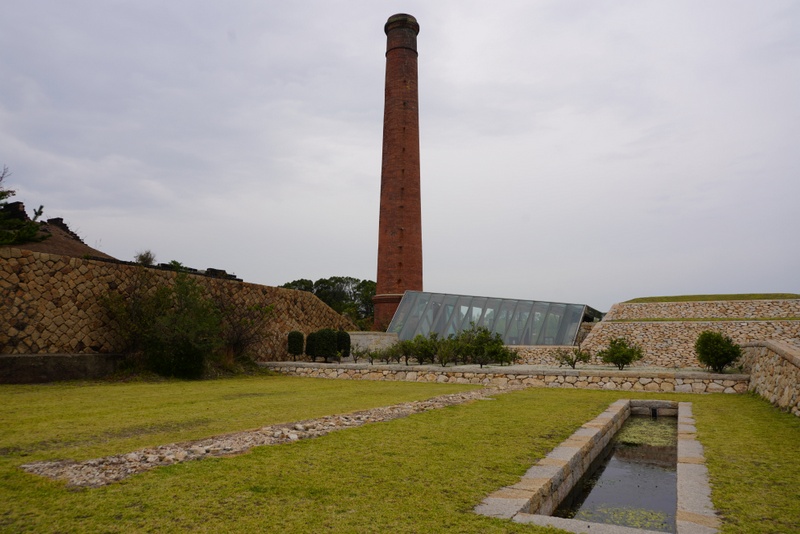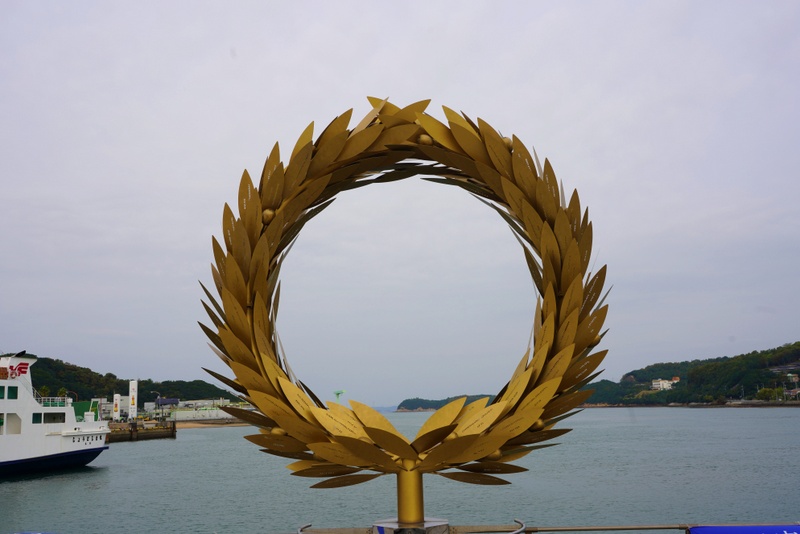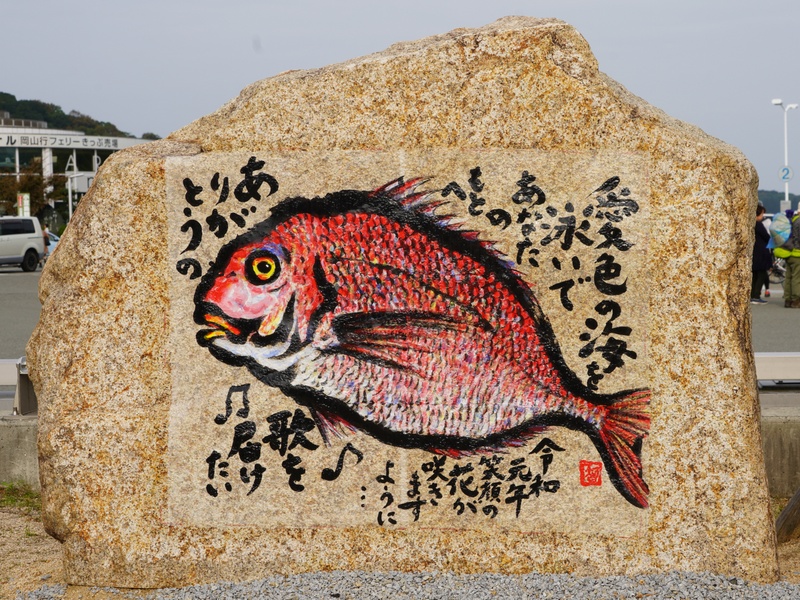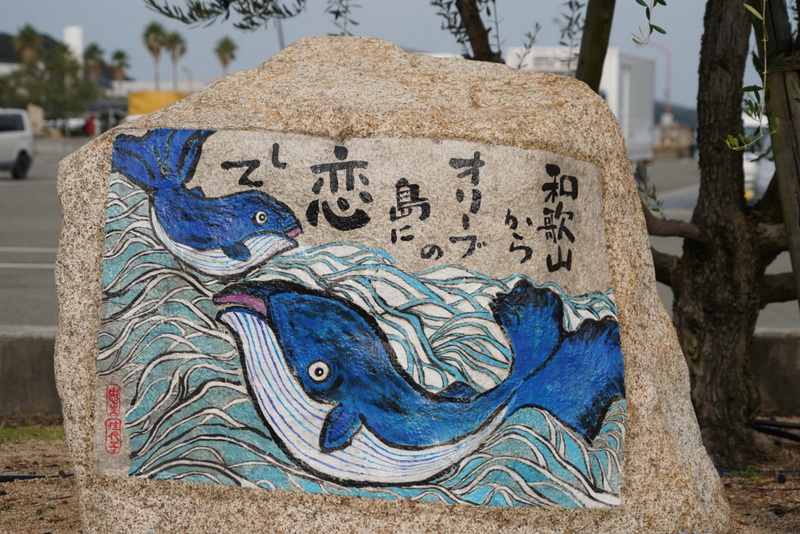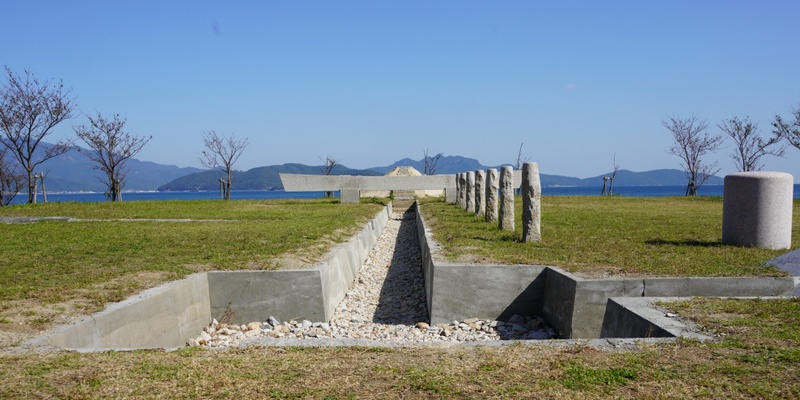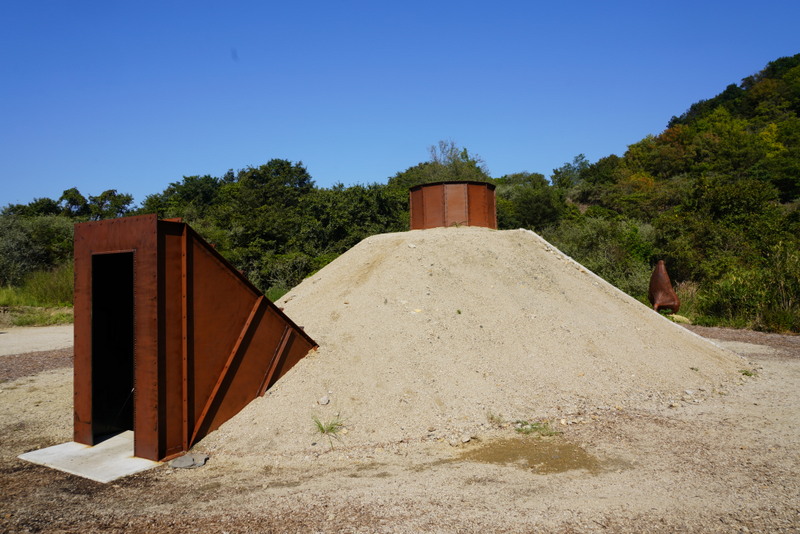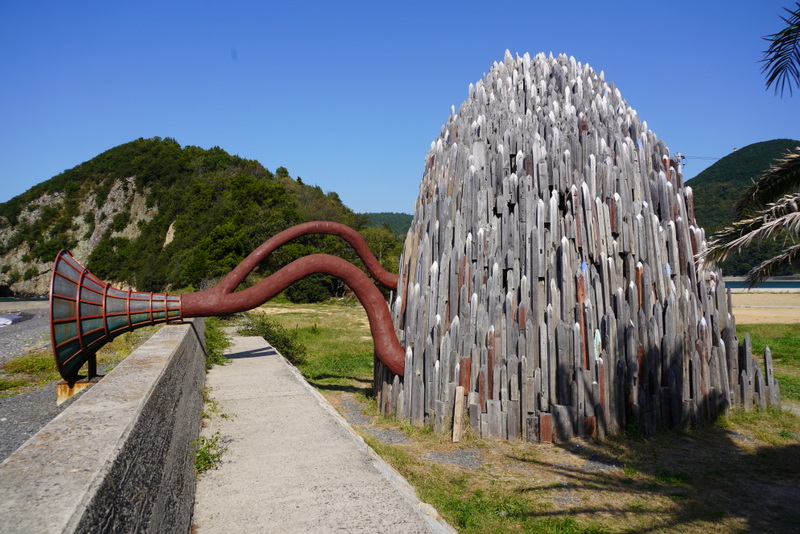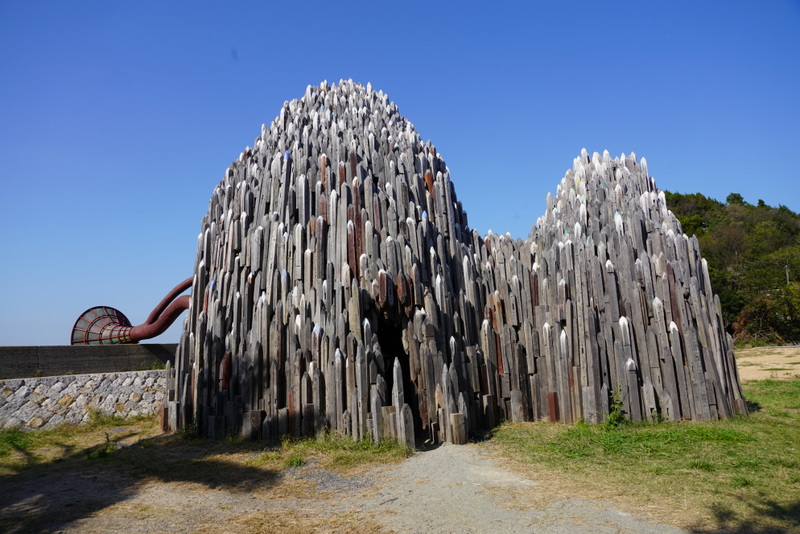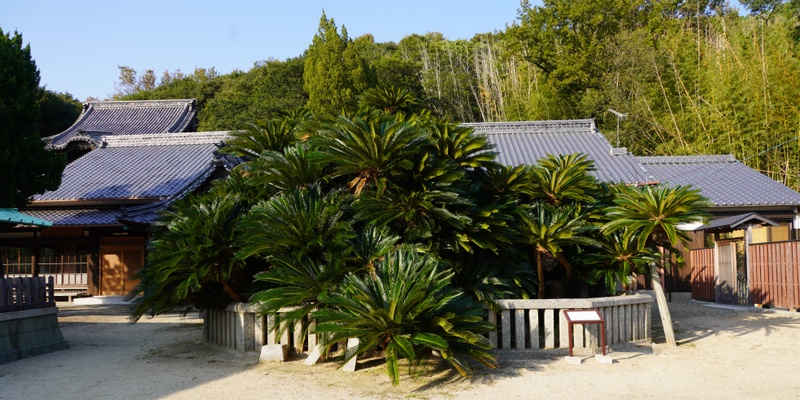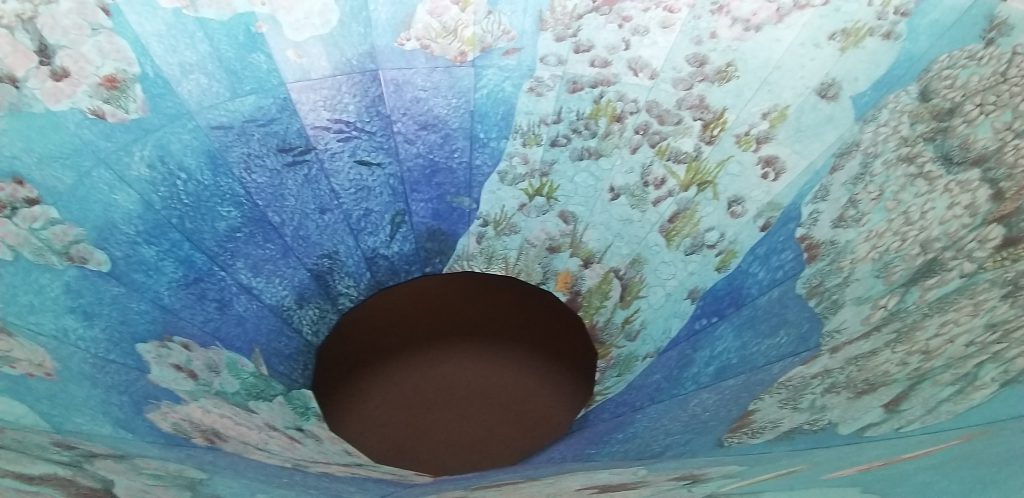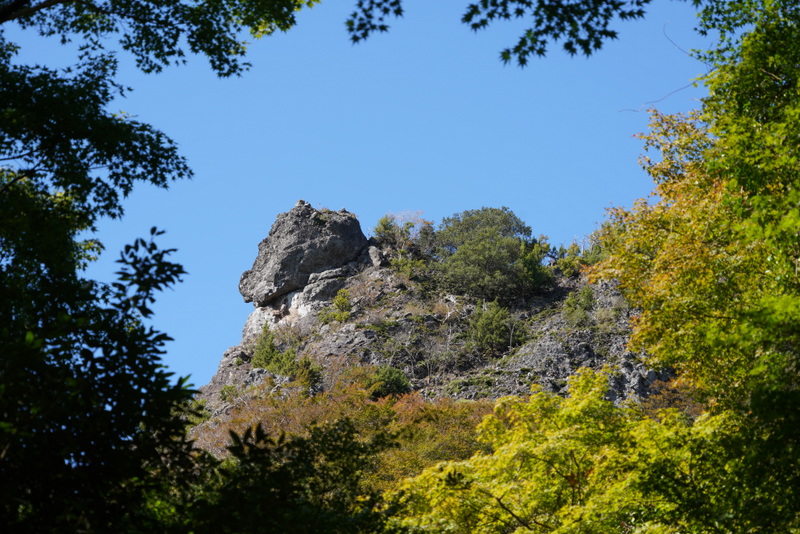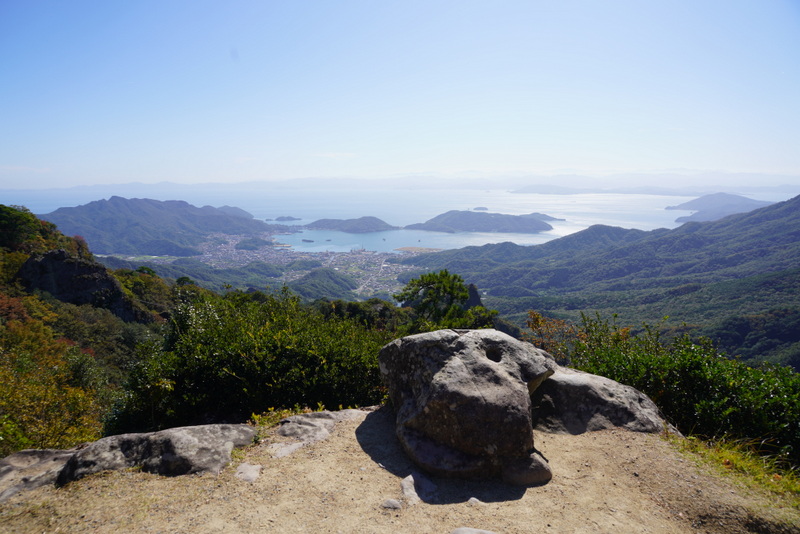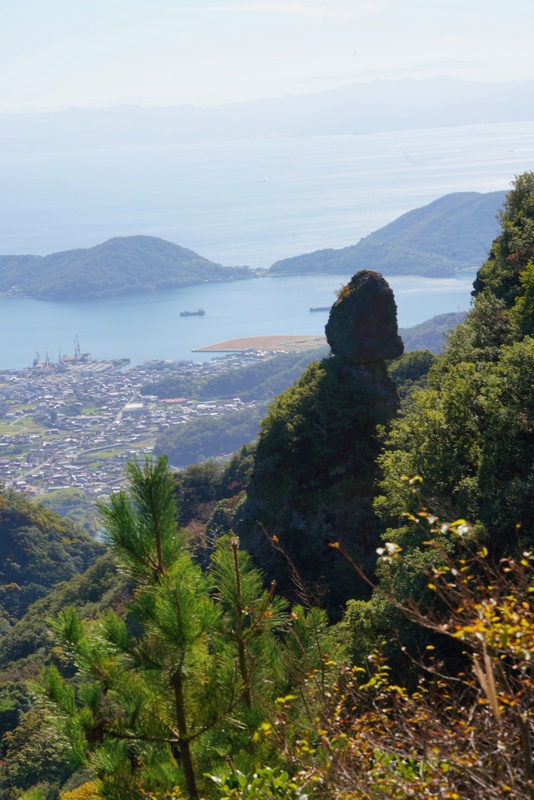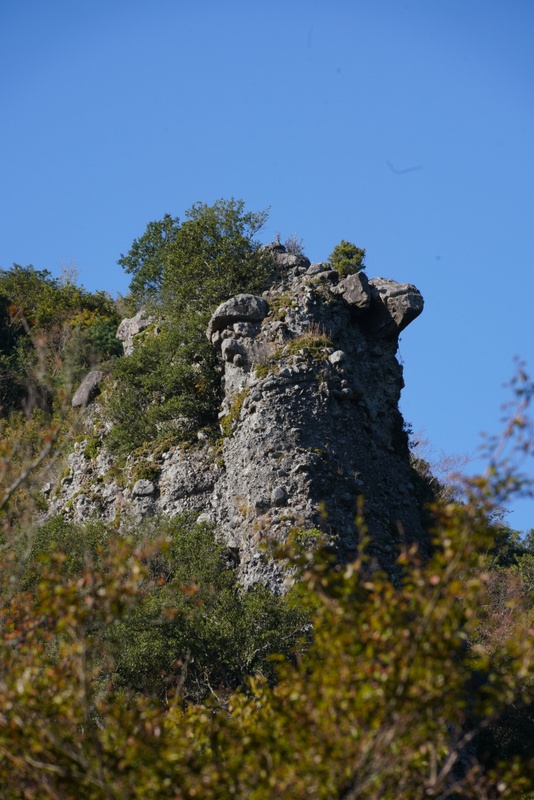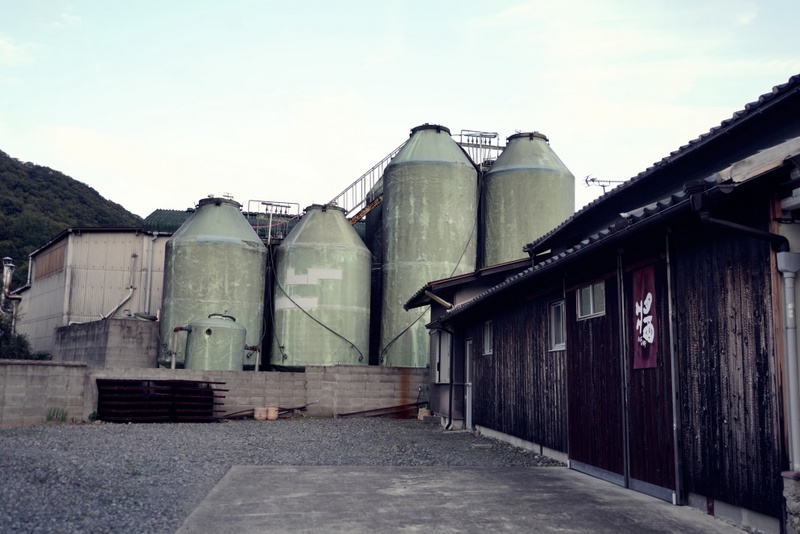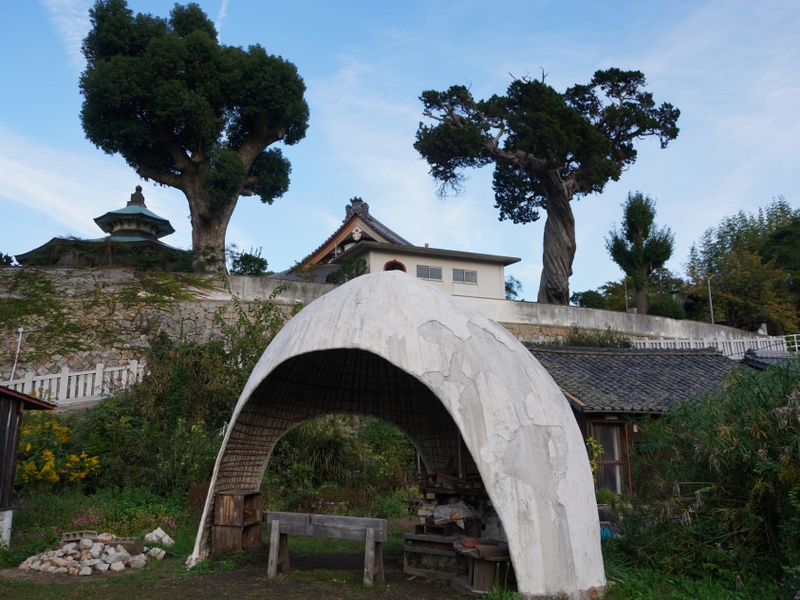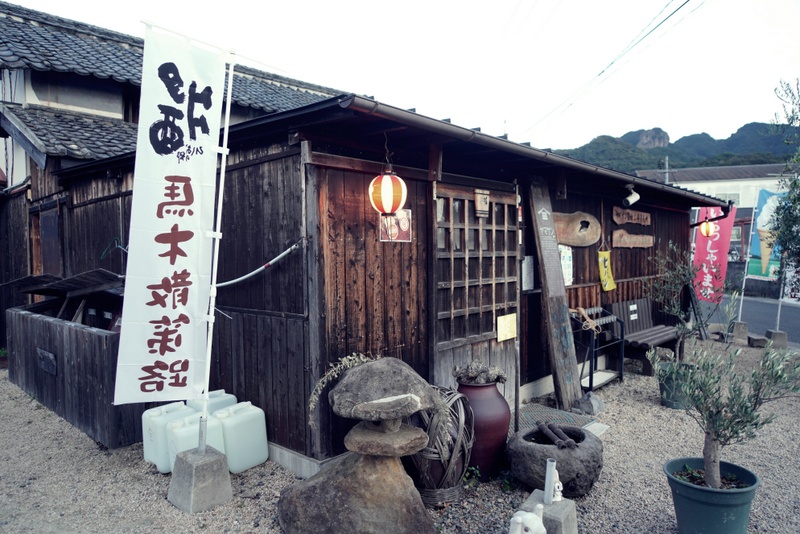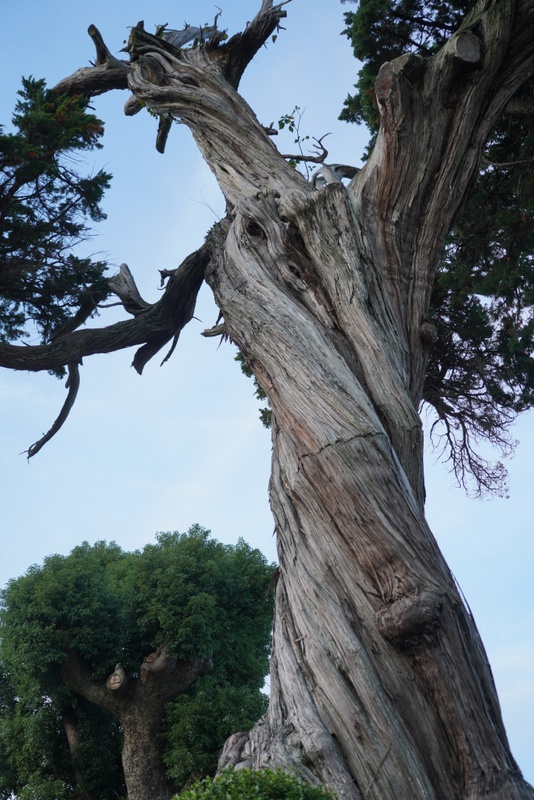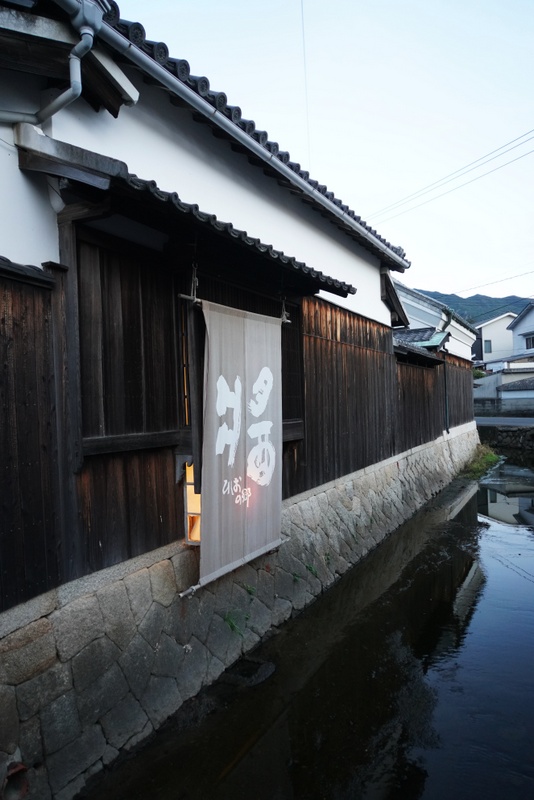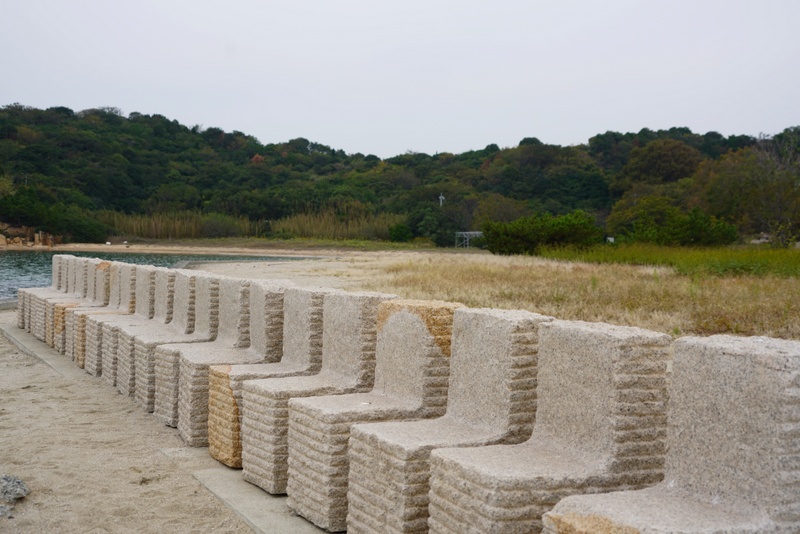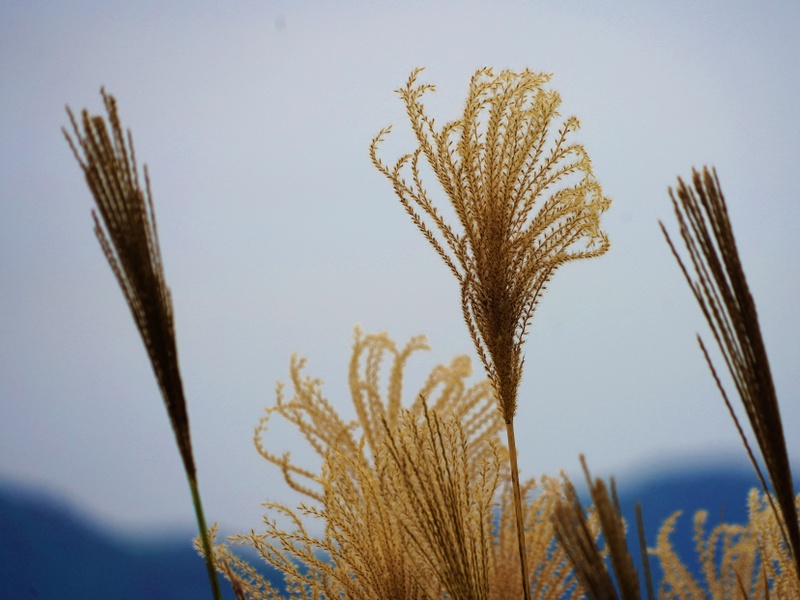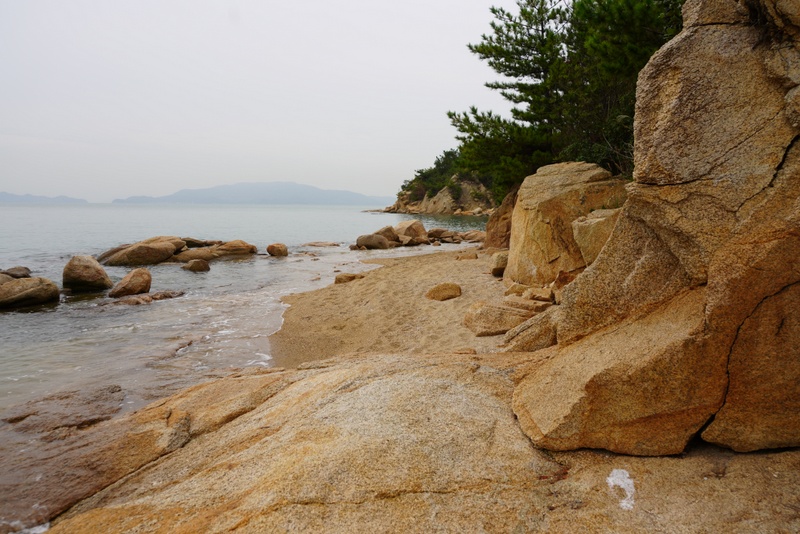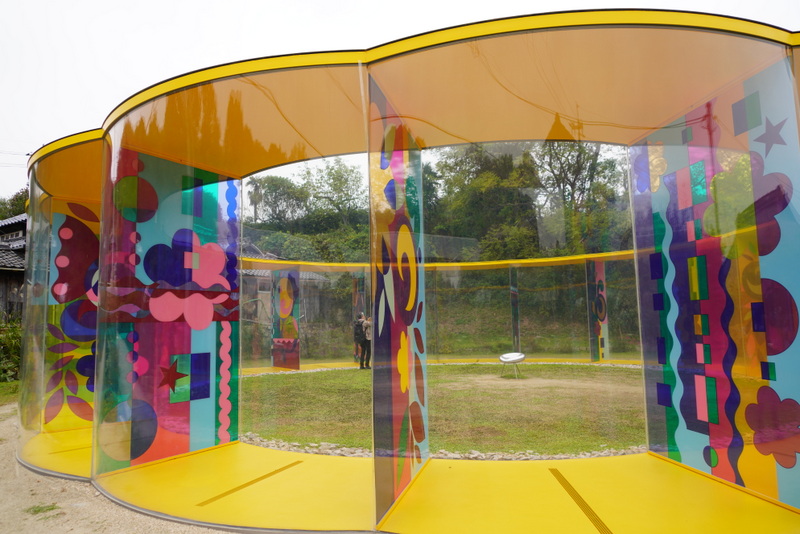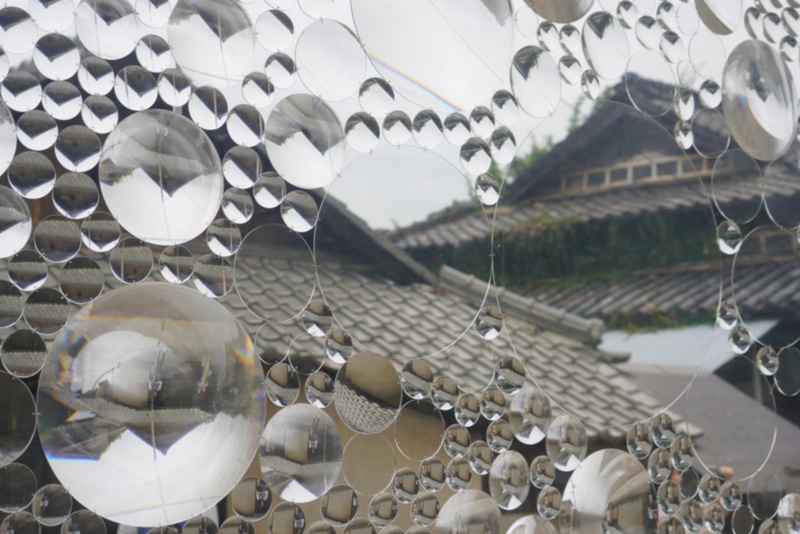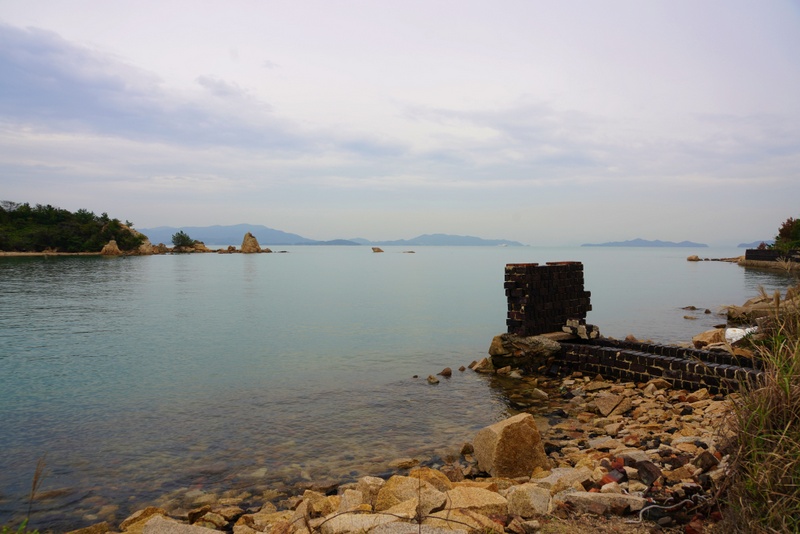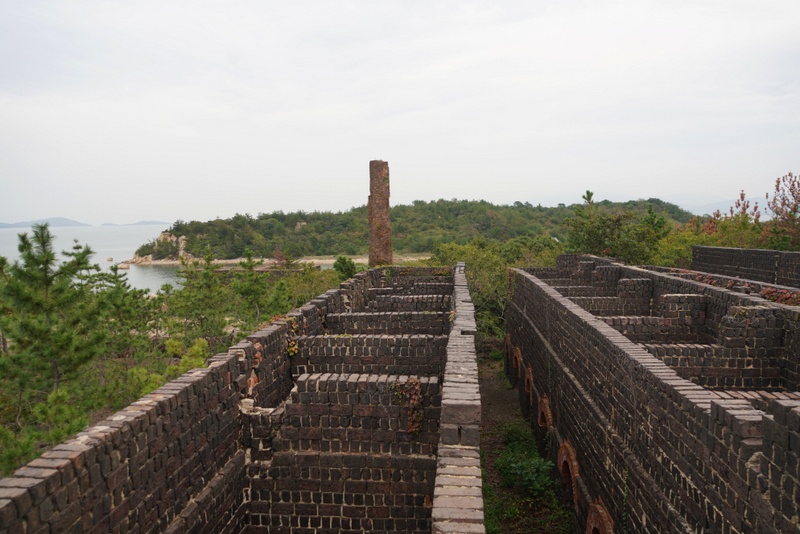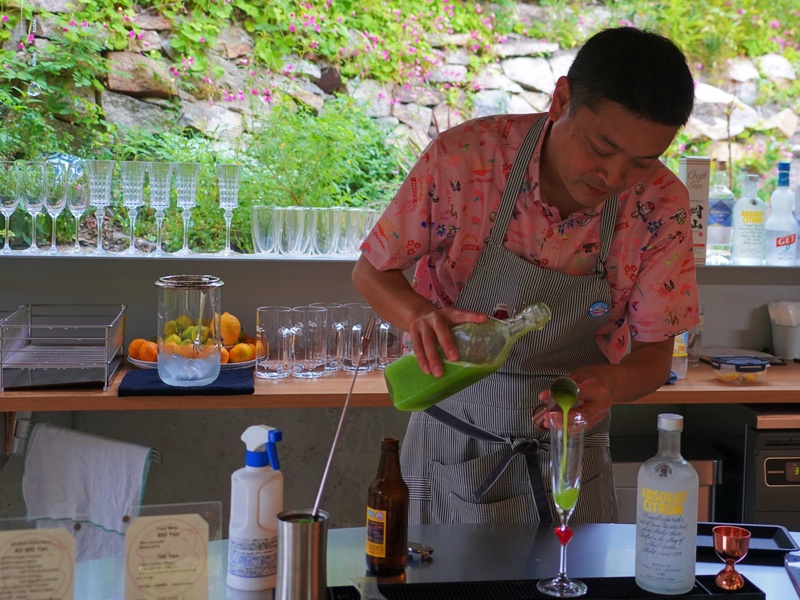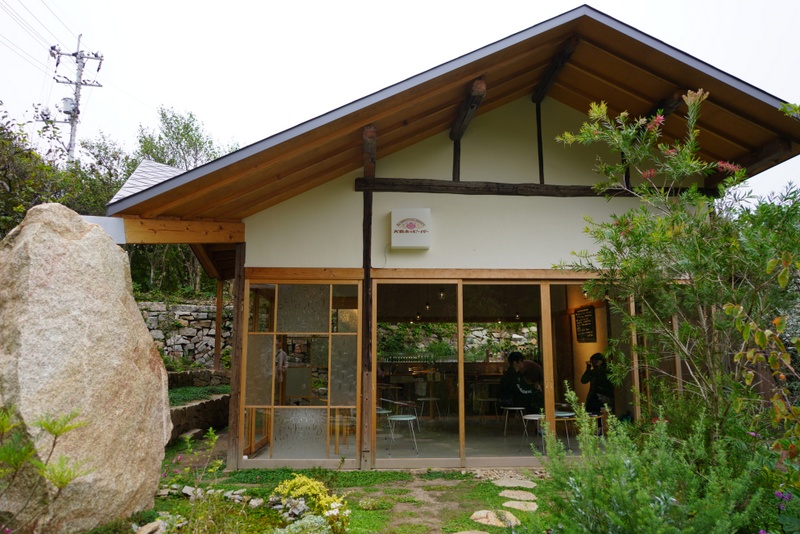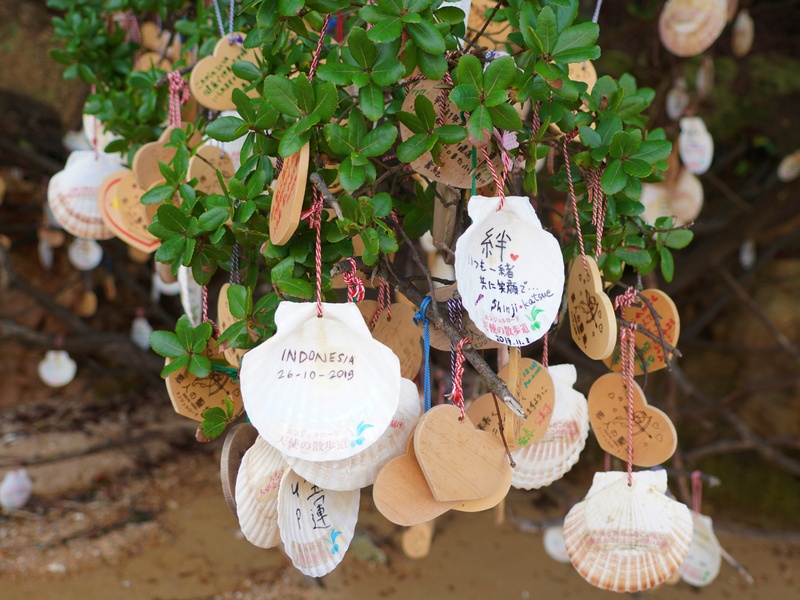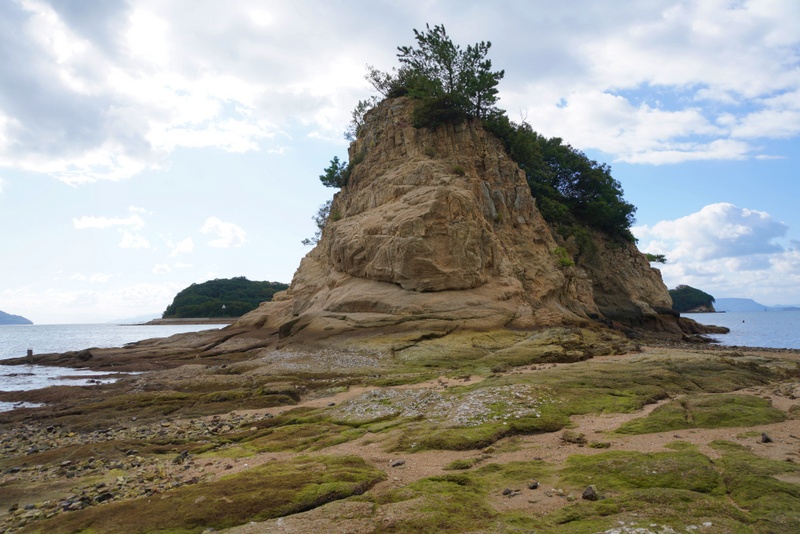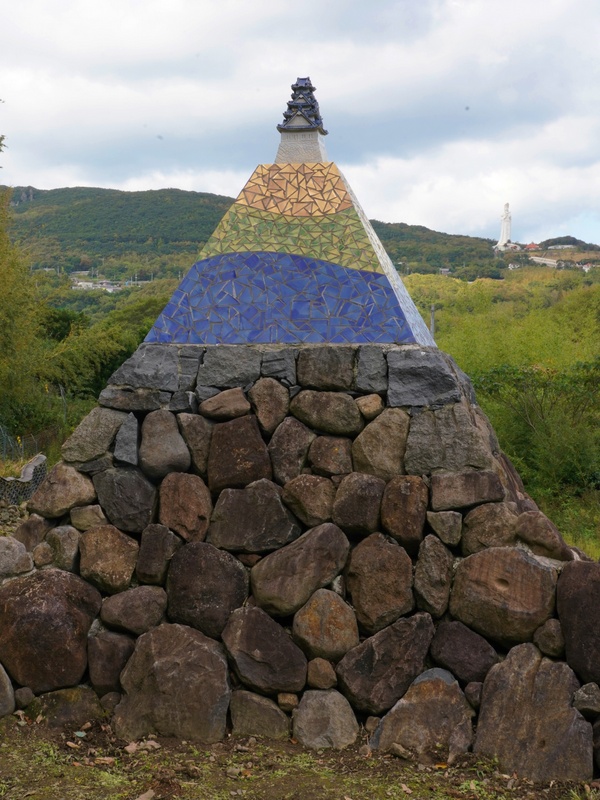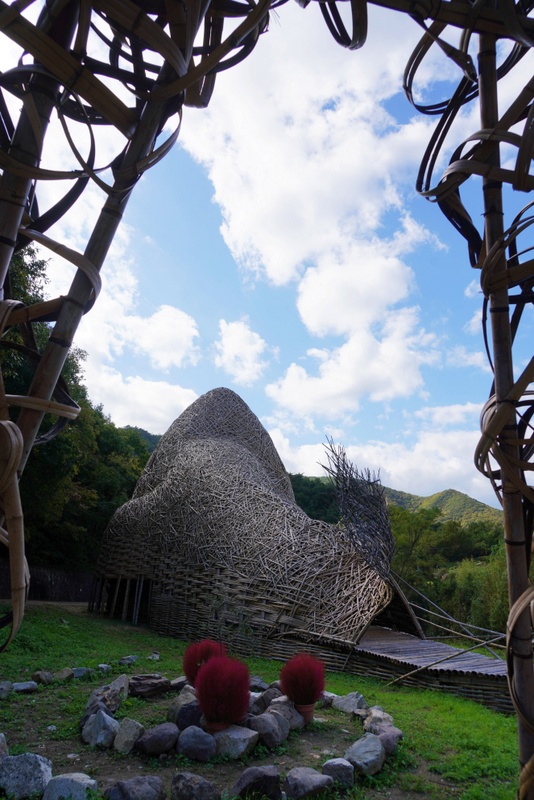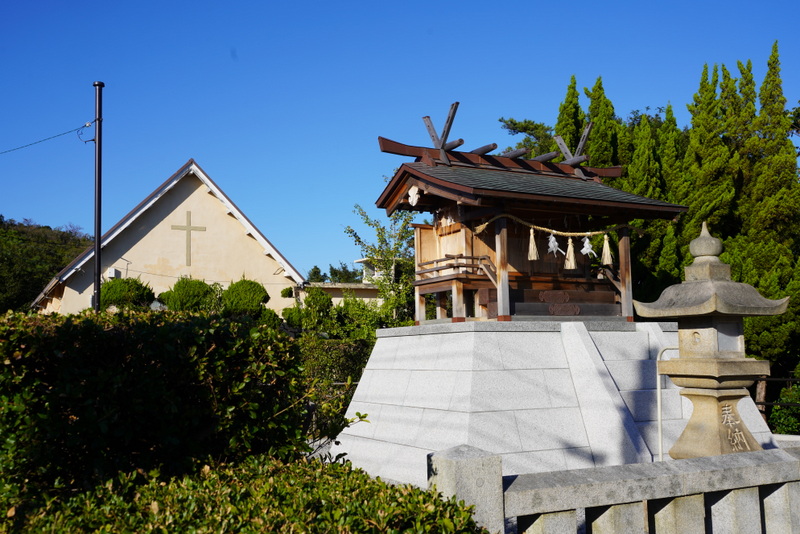November 1 Friday: Shodoshima
Shodoshima 小豆島 with an area of 153km2, a coastline of 126km and a population of about 15,000, is the second largest island in the Seto Inland Sea after Awaji Island淡路島. Being one of the first islands born to the gods in the creation myth of Japan, it has been a popular tourist destination for the Japanese. It has been traditionally a producer of soy sauce.
Being the birthplace of olive cultivation in Japan, it has become known as the “Olive Island”. Shodoshima has also recently been designated as one of Japan’s heritage sites as an “Island of Stones”. During the Triennale, 40 artworks spread across the island with most of them concentrating around the port towns along the southern coast.
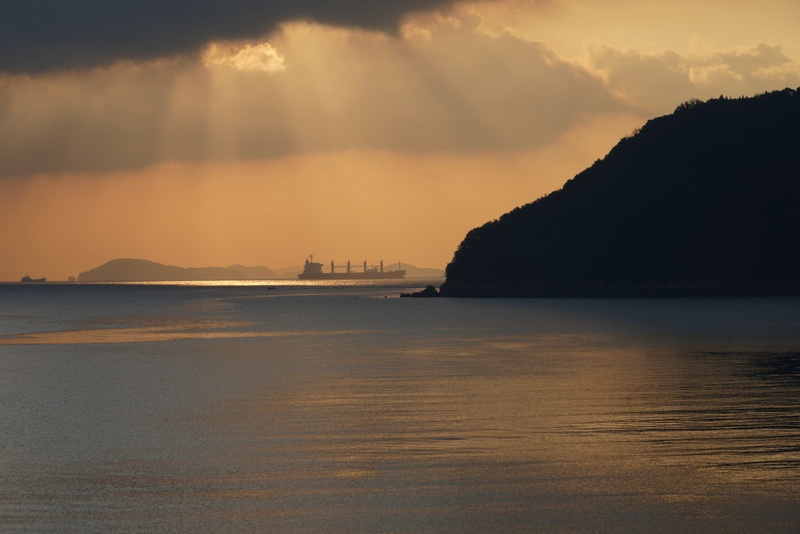
I got up earlier and watched sunrise by the sea
We had to take a bus to the Miyanoura Port to take a high-speed ferry to Shodoshima. It took an hour and cost ¥1,200 pp. We arrived in the Tonosho Port by 10 am and were met by a driver from the Kokuminshusha Shodoshima, a government-run holiday home in the Mito Peninsula. We bought a 2-day bus-pass for ¥1,500.
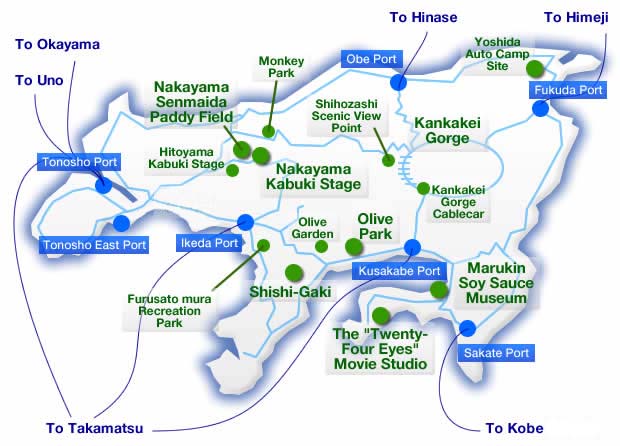
After leaving our luggage at the hotel, we took the bus to Konoura located at the tip of the Mito Peninsula which had a total of ten sites (sd10-19).We arrived at the bus terminal around noon and were immediately taken by a shuttle bus to see three sites. As I had not picked up a booklet in English, I had difficulties to put down some of the names of the artwork and the artist.
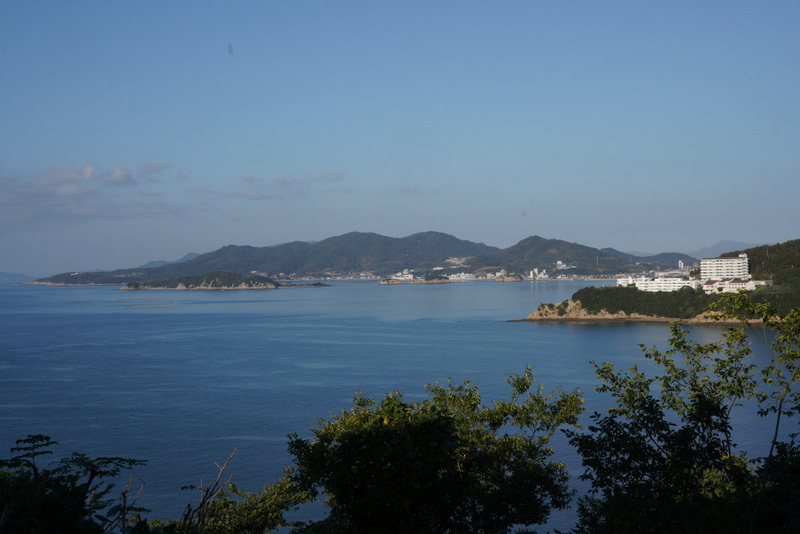
Sd10 “Garden of the Border” by Mitsuharu Doi. I find pyramid-like stone structures impressive.
Sd11 “Eyes of Nature” (from the earth) by Julio Goya who has turned a tree into a house and art space. I like it though the concept is simple.
Sd19 was a cone – shaped structure with most of the space built below ground. Light came through an opening at the top. Nonetheless, one can hear sounds from two ear-shaped structures built outside the main structure. A queer artwork!
Then the driver dropped us at sd17 which was an artwork with light installed in an abandoned factory. Light was projected into a pool of water. It was dark and I did not see well. So, I stepped into the pool and had to put up with wet feet for a few hours.
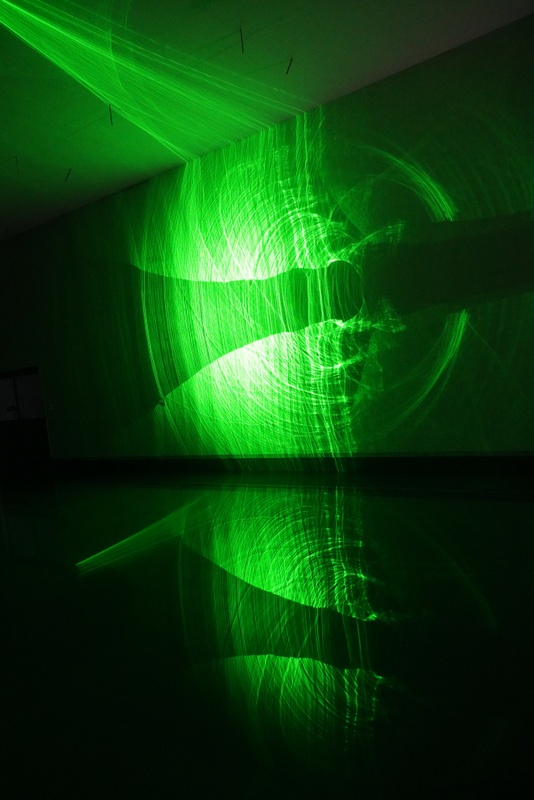
SD17 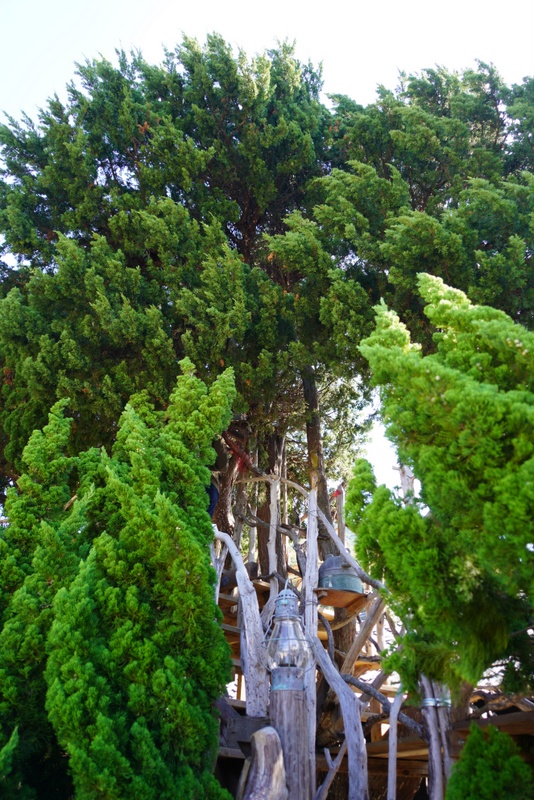
Eyes of Nature
On the way back to the bus terminal, we saw half a dozen works. After searching, I could only find the names of a few artworks: sd12 “Utopia Dungeon” by Keisuke Tanaka, sd13 “Quartz by the sea” by Kaoru Hirano and sd14 “Tomorrow’s Sea” by Mutsumi Tomosada. Most of the artworks were installed in deserted houses.
I find sd16 constructed with wood by the sea more interesting. Inside the art space is two ear-like structures which are connected with the outside by two gigantic trumpet-like structures resting on a seawall.
By the time we saw all the ten artworks scattered around the end of the peninsula, it was around 1:15 pm. We then discovered there was no bus till 2:20pm. We were hungry but there was no eatery at all!
I looked at the tourist pamphlet and found a thousand years old cycads at the Seiganji Temple which is not far from our hotel. I proposed and Kai agreed to go to see it. We got off at the Seiganji Temple bus stop and were delighted to find a convenient store. We rushed in and bought cup noodles and drink for lunch.
The cycads measuring 7.5m in height and 8m in circumference, is Number 1 in Japan for its size and vitality. It is truly spectacular!
Nearby is Furusatomura with an artwork “The Secret of Hanasuwajima” by Kana Kou. One can climb on top to view the work from above or get into the void to look up at this painting of an underwater world with fish, shellfish, weeds etc!
As we were tired, we decided to take the bus instead of walking uphill for another 20 minutes. Once we got on the bus, we thought it would be a good idea to go all the way to the bus terminal to explore the Ikeda Port. But it turned out to be a mistake: there is not much to see around the port. I could have spent my time more meaningfully at the hotel to watch sunset.
The only thing of interest we found was an organic farm/shop with fresh produces. I had an ice cream which is very nice.
As the bus would not be leaving till 6:30pm, we sat inside the port terminal. Suddenly the bus driver rushed in and put us in touch with the hotel’s driver who was at the port waiting for a few guests. As a result, we were able to take the shuttle bus back to the hotel shortly after 6 pm. Drivers in Japan are efficient, helpful and professional.
We were hungry and ordered a full dinner set. Though the dinner was not cheap (over ¥3,000 pp), the food was average and not value for money at all. Anyway, I like the hotel which has both good views and a nice onsen.
November 2 Saturday: Shodoshima
We took a free shuttle to the ferry pier and left our luggage in the guesthouse we would stay tonight. Then we made a trip to the Kankakei Gorge which is considered one of the three most beautiful valleys in Japan. First formed by volcanic activities about 13 million years ago, the gorge boasts unique shaped rock cliffs decorated with colourful trees especially in autumn.
We had to take two buses to reached the ropeway station at an elevation of 295m. We got off the bus around 11:20 am. While most passengers took the 5-minute cable car ride to the summit (612m), we opted for a hike and made an ascent via the Omoto (front side) 12 scenic trail which is shady, well-marked and easy. We took an hour and enjoyed the scenic spots.
Once we reached the top, we stopped at the Shibocho Observatory and later Takatori Observatory with good views of the sea, mountain ranges and rock formations. Unfortunately, the autumn colours had not arrived yet.
We had lunch at the Mikasa Plaza and then followed the Ura (rear side) 8 scenic trail going downhill. The path is steep and slippery with many loose rocks at the upper part.
It was a stressful descent. Anyway, we were glad that we had taken this trail which took us to see the Stone Gate (a natural rock arch) and the Cave Temple built into the cliff. Both sites are impressive.
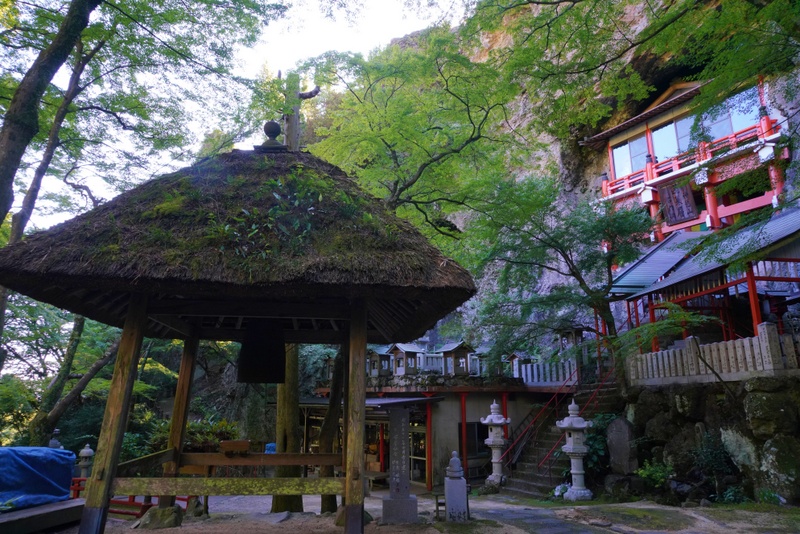
We finished our hike just before 3 pm. But there was no bus till 3:47 pm! We waited patiently and decided to take a ride to visit the soy sauce village around Umaki which had seven artworks (sd 22-28).
By the time we got off the bus, it was approaching 4:30pm. Most places would be closing soon. We strolled aimlessly around the soy sauce village looking at some of the factories from the outside. We also saw a few outdoor artworks (sd24, 25 and 28) and a temple.
I am not impressed by the few outdoor works I saw here. But the stroll around the traditional soy sauce village was atmospheric. I like the smell too.
We took a bus after 6pm and had a simple dinner in a local restaurant called Sunami run by an elderly couple near the port. I ordered chicken which was OK. But Kai’s sashimi set was meagre. He had to go to 7-Eleven to buy snack to fill his stomach afterward.
November 3 Sunday: Inujima
Today, we took the 10:05 am high-speed ferry to Inujima 犬島. The journey took 25 minutes but cost ¥1,200. Upon arrival, everyone rushed to the ticket office to get a return ticket as there were only two ferries available. We got tickets on the last boat at 4:30pm and were able to spend the whole day on the island.
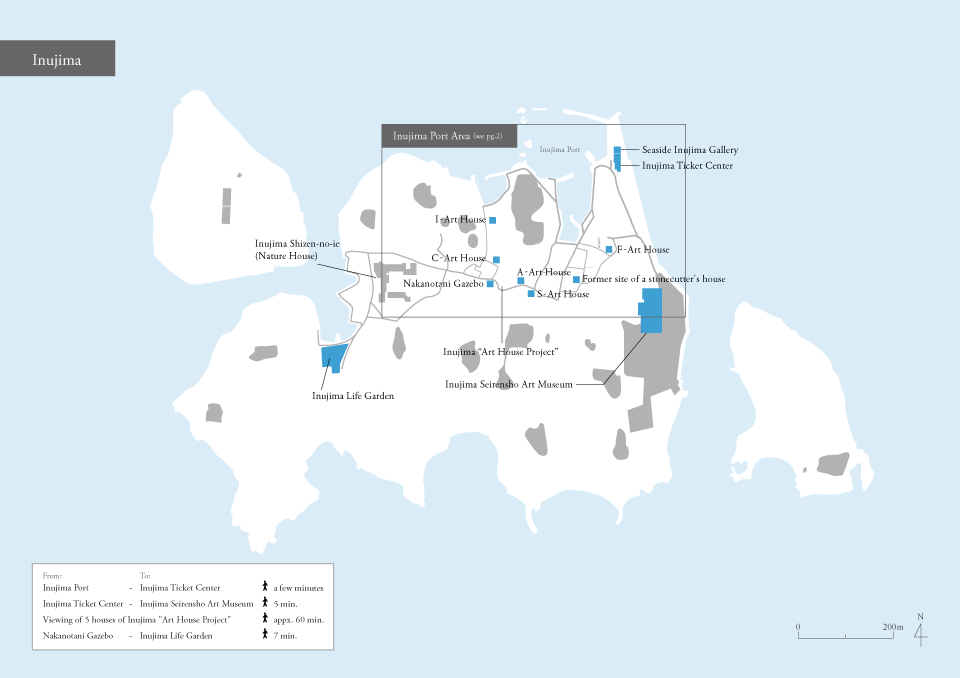
Inujima with a circumference of about 4km is known for its high-quality granite which had been used for the stone walls of Okayama Castle and Osaka Castle. After the opening of the copper refinery on the island in 1909, more than 5,000 people lived here at its peak. The refinery was shut down after ten years because of sharp fall of the price of copper. Today, only about 50 inhabitants still live on the island.
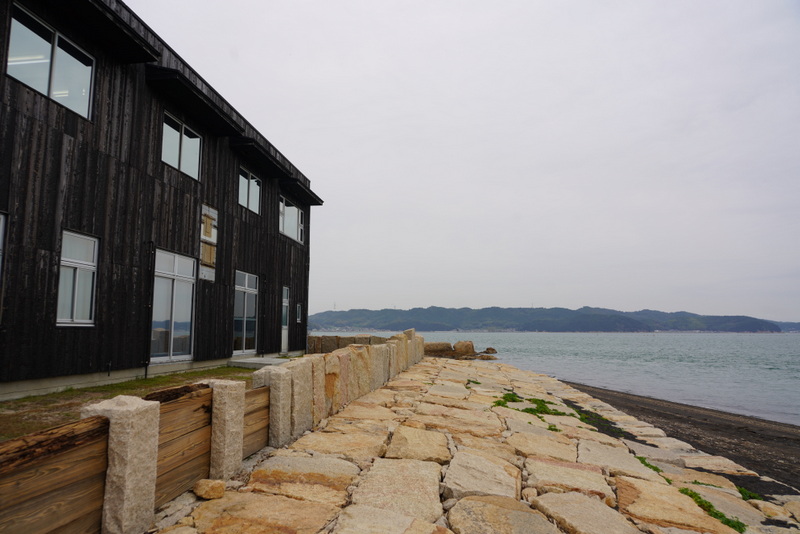
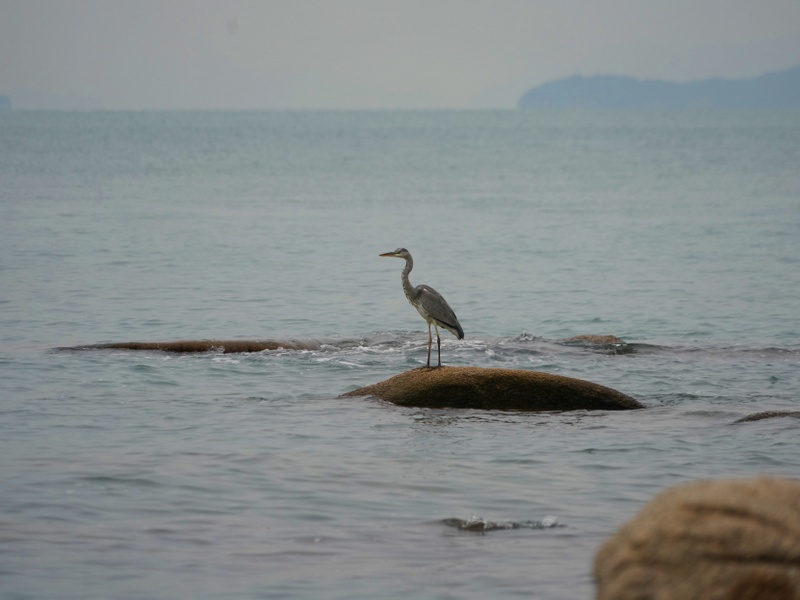
The island has emerged as a place of note when remains of the refinery were restored as a heritage of industrial modernisation and turned into a museum. Inujima Seirensho Art Museum opened in 2008 was built around the idea of ‘using what exists to create what is to be“. A new model of community revitalization based on the idea of “heritage, architecture, art and the environment” has provided new impetus for the island.
It was a grey and windy day. There were 11 art sites on the island. As most visitors headed towards the art museum, we walked the other way to avoid the crowd. As it is a small island, it is easy to explore it on foot.
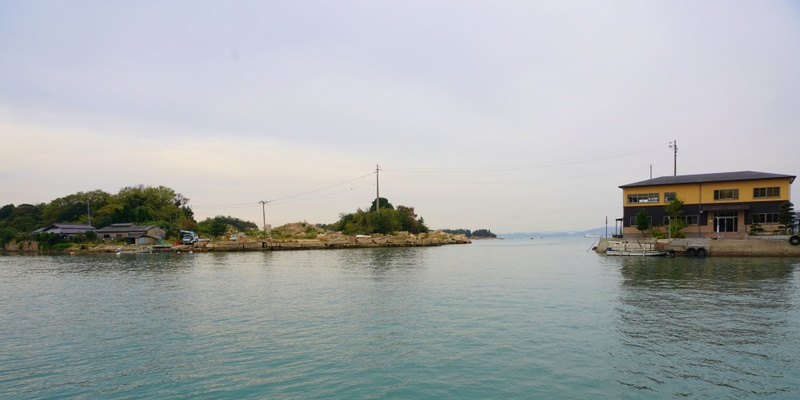
I like the “Art House Project” comprising five galleries initiated by artistic director Yuko Hasegawa and architect Kazuyo Sejima. They are creative and hope to change and revitalize the island’s landscape with their works.
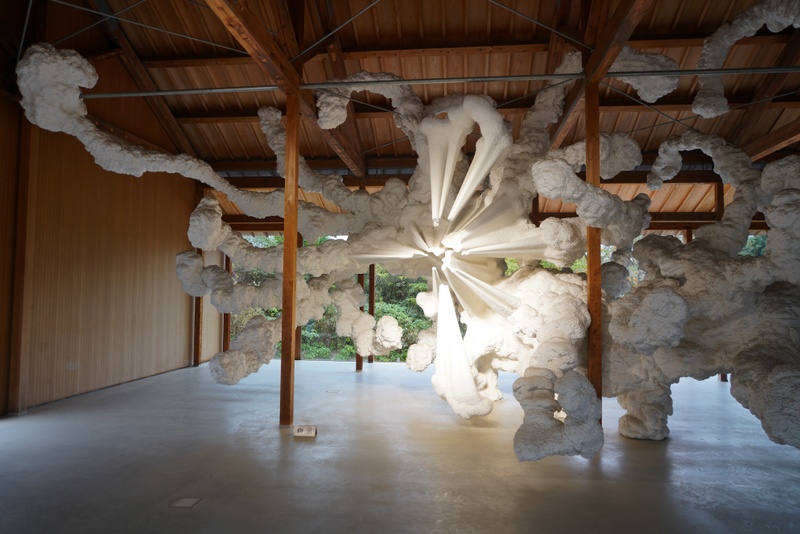
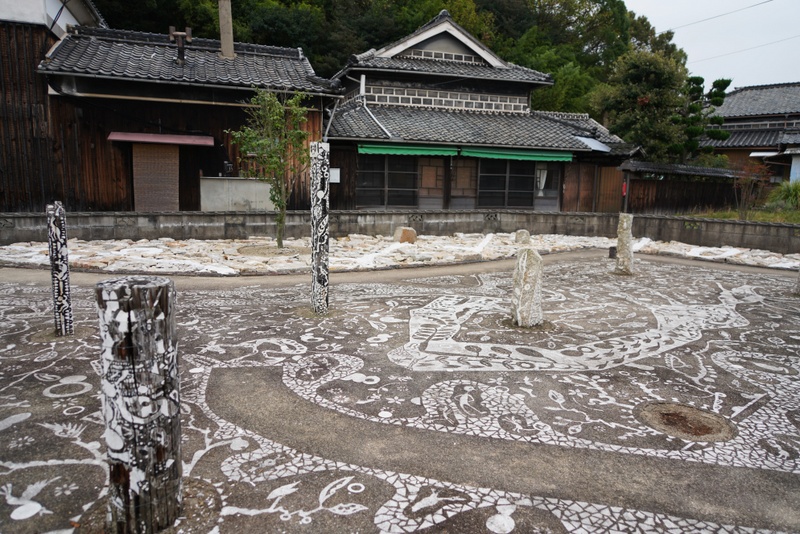
I also like the “Life Garden” which is like a garden for the local community with a green house. The small plot of land is filled with plants and flowers with a few chickens running around.
From here, one can walk to the beach and reach the art museum. Kai apparently took this route while I wandered around the hamlets by the harbour.
The island is tiny with only a few paths. Soon, I came across Kai at a crossroad. We found a local eatery and had a wholesome lunch with fish and miso soup for ¥1,000. Tourism would be good for the local economy.
After lunch, we visited the Art Museum. By now, most visitors had gone and I was able to discover it leisurely. The artist and architect create an interesting site-specific artwork. The interior was dark and like a maze with narrow corridor. With the background sound, I felt I was inside a furnace. Wherever I turned my head, I could see burning fire and people behind me. It is once again all about experience, atmosphere and emotion.
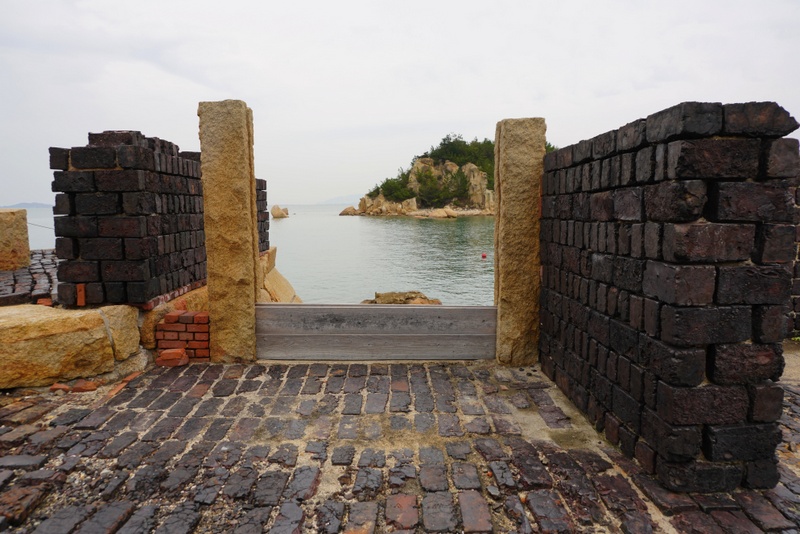
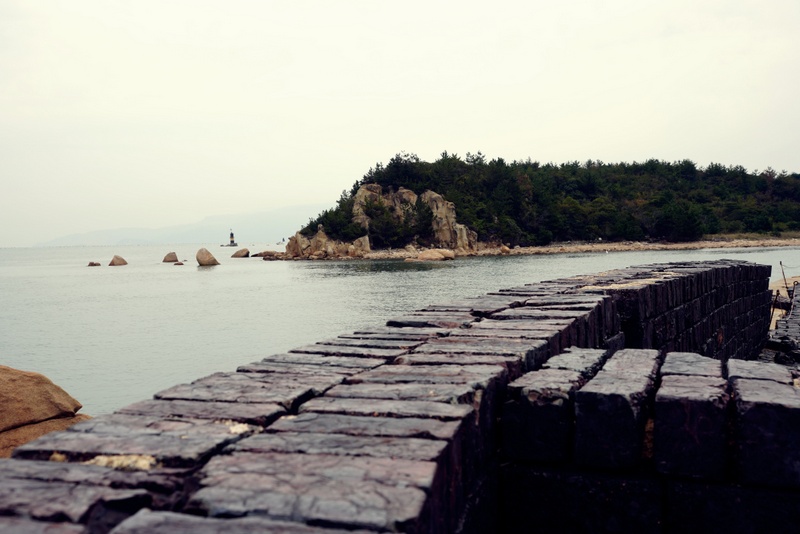
As I still had plenty of time, I walked to the beach behind the museum, saw many rock sculptures and arrived at the “Life Garden” again.
I even had time to stop at the Inujima Hoppy Bar for a cocktail. The bar built with wood is trendy. It only opens from Friday to Sunday. I had a drink in order to support the local economy.
By the time I turned up at the pier at 4 pm, there was already a long queue. I took the last but one seat on the ferry! We were back in the Tonosho Port around 5 pm. Tonight, we stayed at the Okido Hotel right by the ferry pier. Their single rooms are spacious and comfortable. We had a sumptuous dinner (¥3,500pp). I finished off the day at the hot spring bath.
November 4 Monday: Shodoshima
While Kai would be returning to Takamatsu today, I would spend one more day on the island. But I found another interesting traditional seaside onsen resort with a good price.
No visitor to Shodoshima would leave without visiting the Angel Road, asand path that appears twice a day during low tide.
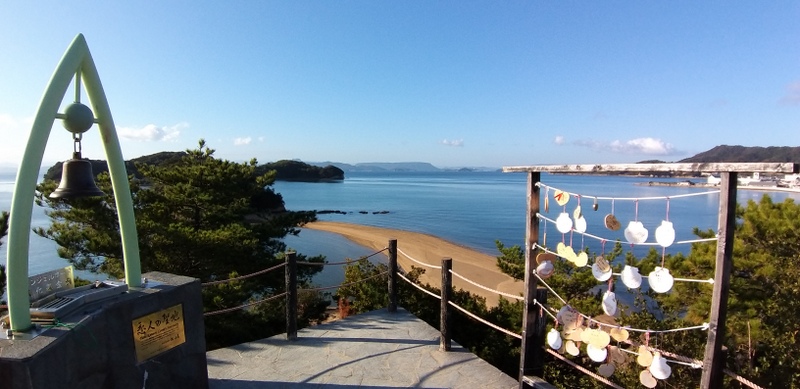
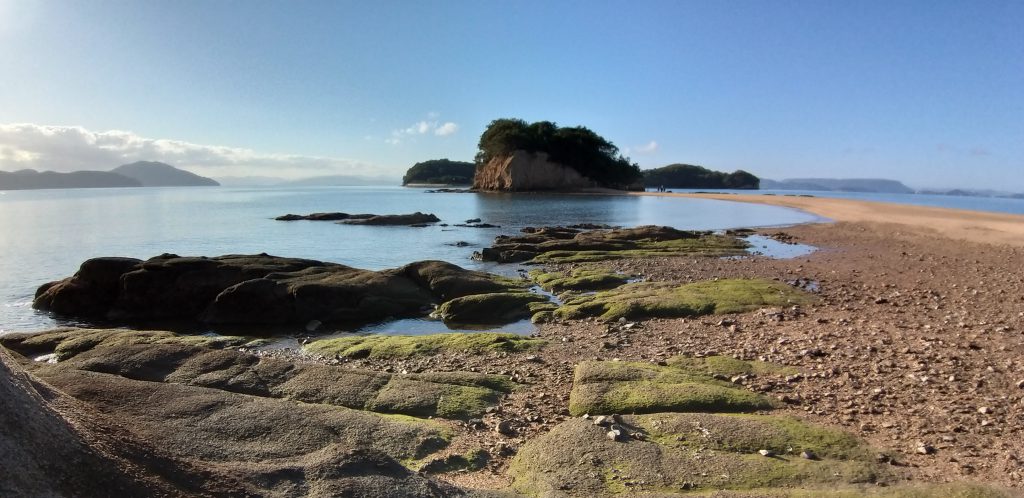
We took a bus at 9am to visit this famous landmark. After a whirlwind visit, Kai left in order to take the 10:25 am bus back to the ferry pier. He told me the next bus would be 10:38 am. But there was no bus till almost 11:30 am.
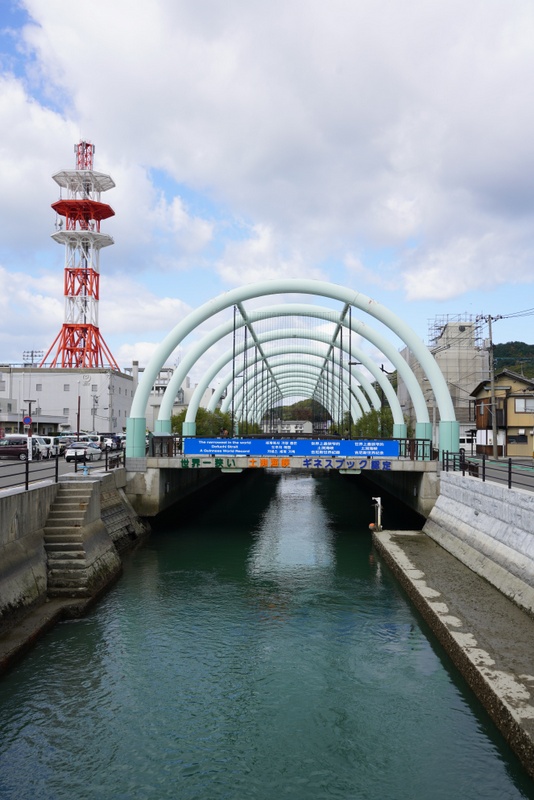
I got a day bus pass for ¥1,000 without fixed plan for the day. As I would not stand at the bus stop for an hour, I decided to walk back to the pier (about 30 minutes on foot). On the way, I could take a picture of Dofuchi Strait土渕海峡, the world’s narrowest channel, the narrowest part of which measures only 9.93m.
After taking a photo, I suddenly caught sight of a bus nearby. I rushed up and found it was a special bus heading to Nakayama where there were four artworks (sd06-08 & 14). This area was on my list.
On the bus, I sat next to a man from Tokyo who had come specially for the festival. We therefore walked together along a nice path with terraces and paddy fields under cultivation.
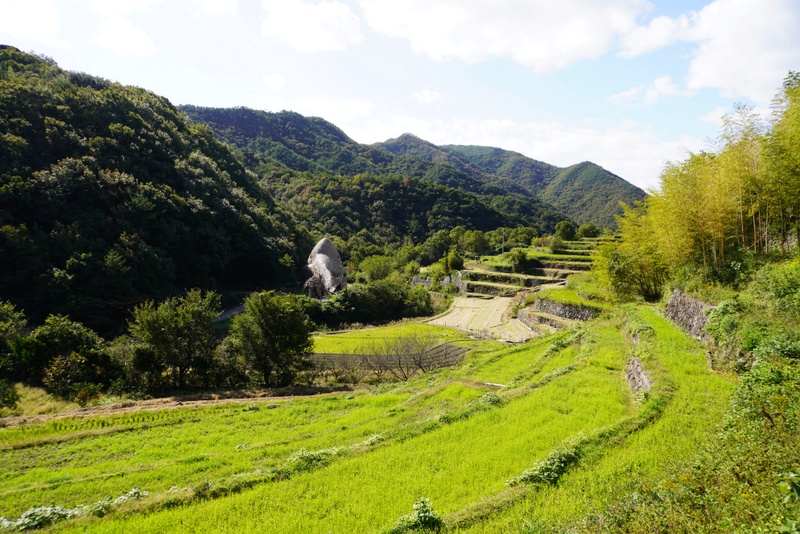
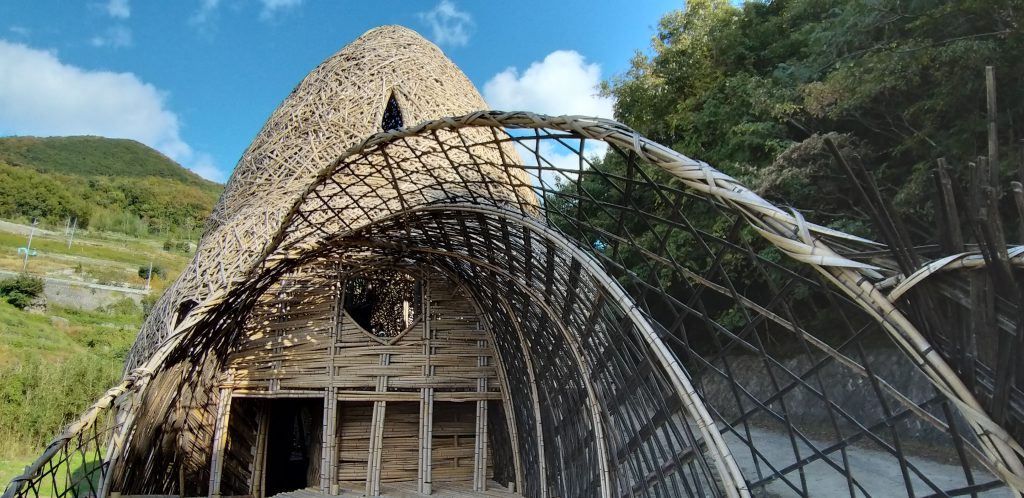
The more impressive artwork in this picturesque valley is sd08 built with bamboo by Wang Wen Chih. Visitors could sit and meditate inside the art space. The terraces of paddy fields and hills behind provide a fantastic backdrop of this piece of artwork.
We managed to see all the artworks before taking the bus at 2:15pm. With my day pass, I decided to take a bus tour around the island. By now, I knew the major bus routes well. I got off at the hospital in Ikeda just in time to catch the bus heading to the Fukuda Port at the north-eastern end of the island.
I got off the bus around 1:10pm. Fukada had two artworks. I only had time to see sd35 which resembles another art house project. This time, an open was made to accommodate a tree in the middle of the site.
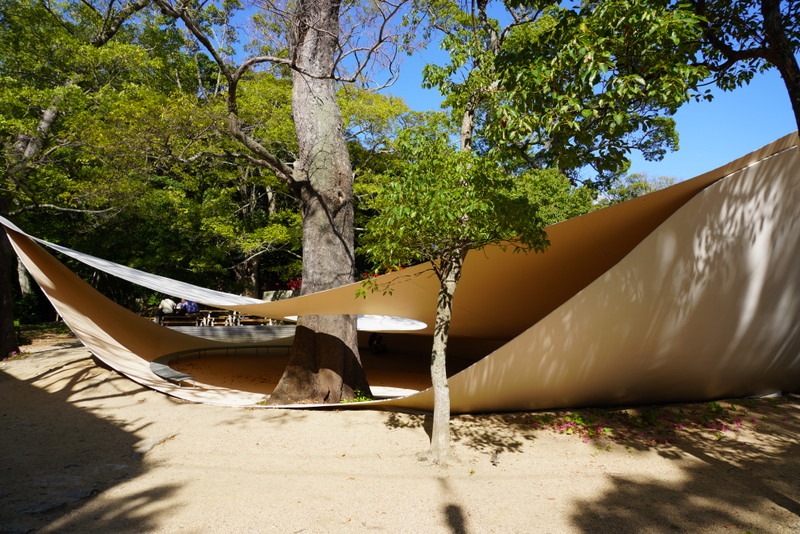
The buses are infrequent. I could either take the one at 1:30 pm or 3:30pm. As there was not much to do in Fukada, I decided to take the one at 1:30pm. When I discovered the bus would pass close to the Tonosho Port, I decided to get off. But I could not find my day pass which I had shown to the driver before getting on the bus.
I did not want to hold up other passengers. Hence, the bus driver drove on while I searched my pockets. At the end, I could not find it and was told to pay ¥300 for a ticket. As the bus ended in Ikeda, I had to wait for another bus and pay ¥300 to return to the port. At the end, I spent a total of ¥1,600 on bus tickets. What a frustrating experience!
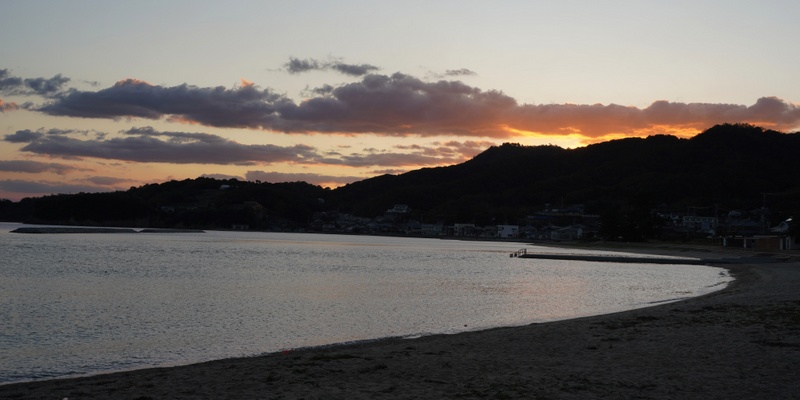
After picking up my bag from the hotel, I took a shuttle transfer to Shodoshima Seaside Hotel Matsukaze opposite a beach. The hotel management was kind and upgraded me to an excellent suite with a balcony facing the beach. I gave myself a treat after a frustrating day: I had a dinner set with sake for over ¥4,000. I had a nice soak in the onsen too.
November 5 Tuesday: Takamatsu
I got up early, borrowed a bicycle (free) from the hotel and planned to go to Hosho-in Temple to look at Japan’s biggest shimpaku (juniper tree). I have overestimated my ability. When I saw a steep uphill climb, I gave up and headed back to Angel Road. I have problems with my knees and hips and cannot take risks.
I found Angel Road more beautiful this time. The morning light was soft and perfect. It was tranquil with few tourists

I took the 9:15am free shuttle bus to the ferry pier after having seen about 20 artworks on the island. The ferry (¥700 one way) took me back to Takamatsu and I checked in Hyper Inn near the port and the railway station. My suitcase was broken. My first priority was to go to the mall to get a new one.
Kai’s flight was in the late afternoon. We met up for lunch before I took a free ferry to Oshima 大島around 2 pm. The island with an area of about 62 hectares, has served as one of the 13 national facilities for Hansen’s disease. At its peak, it housed 744 residents with the disease. Today, the population is below 55.
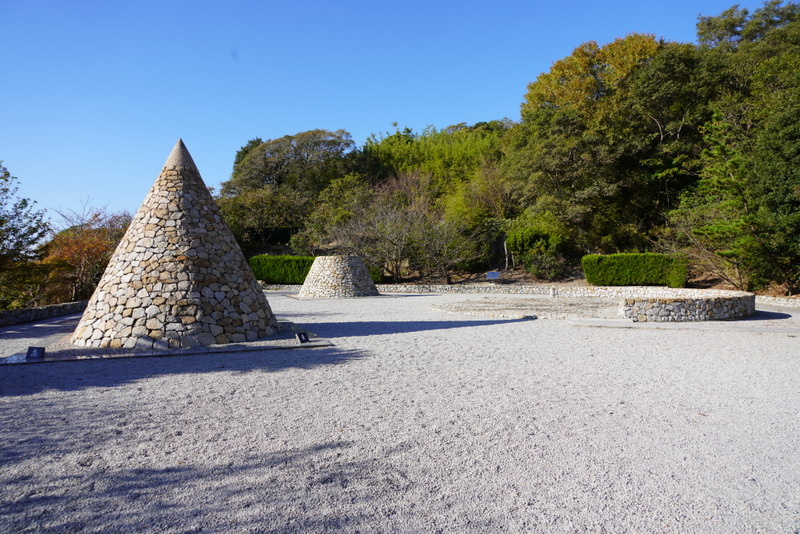
I arrived in the island around 2:30 pm. The island is leafy and quiet. During the festival, the hospitals, residents and artists collaborated transforming this stigmatised and isolated island into an art gallery. Though the festival was ended the day before, I was hoping to see some of the artworks. Unfortunately, most of the artworks had been removed.
As the next and last ferry would not be leaving till 4:30pm, I had to spend two hours on the island. I took a stroll and saw half a dozen temples and a church. Apparently, the six religious groups have been looking after the survivors’ spiritual needs and eventually their burial.
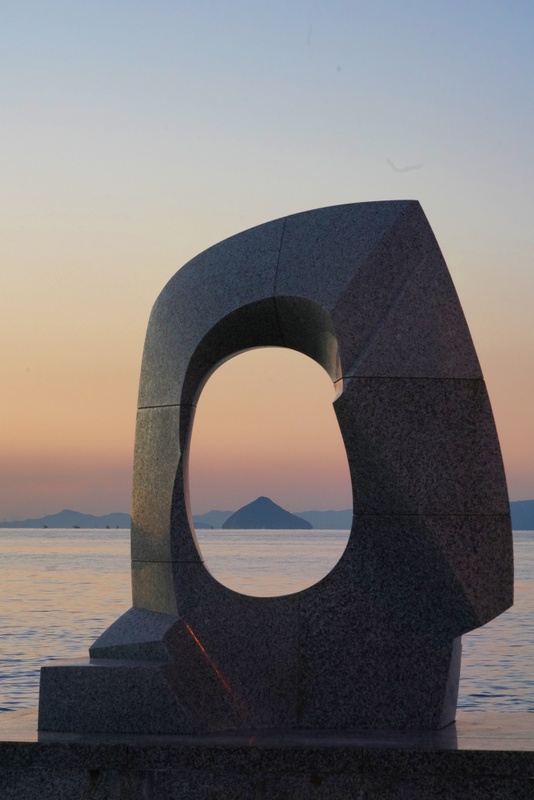
I spent a while in the memorial museum which had a grand opening in April 2019 to mark its 110th anniversary. The exhibition is centred around the six themes centred around residents’ lives on the island. The six keywords that symbolises activities that provide support for their existence are “Admittance”, “Gathering”, “Worshipping”, “Working”, “Enthusiasm” and “Rest”.
The tranquil island is close to Takamatsu. It looks peaceful but I somehow can feel the anguish, shame, prejudice and discrimination these people must have suffered. Anyway, I had hardly seen anyone apart from a few workers. I had a quiet evening working on my travel notes.


